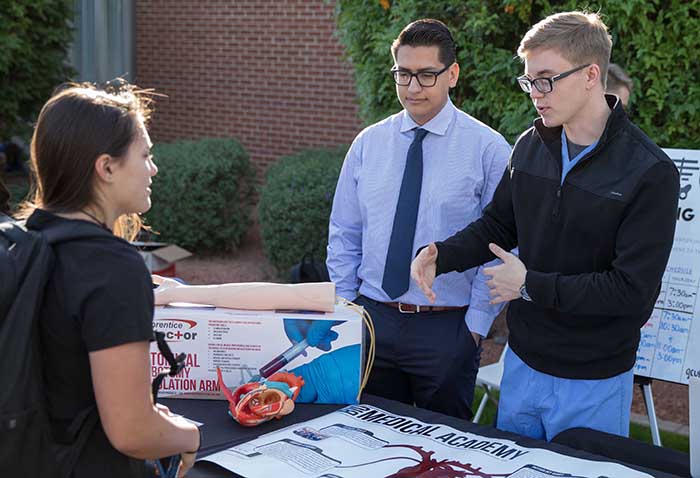
Story by Lana Sweeten-Shults
Photos by Slaven Gujic
GCU News Bureau
Apollo, Taco and Mortimer were busy on Health Sciences, Engineering and Technology Day on Wednesday, when more than 2,300 science-loving high school juniors and seniors from around Arizona descended on GCU's campus.
Apollo and crew shook things up.
Literally.
It’s just what they do.
That's because Apollo, Taco and Mortimer aren't humans but Thermomixers nestled comfortably in the DNA Lab on the fourth floor of GCU’s College of Humanities and Social Sciences. Students recently placed the swab of a bite mark in one of the mixers for forensics analysis and a swab from a soda can in another.
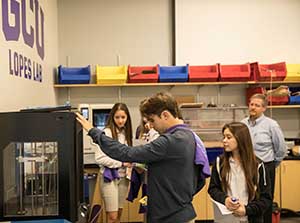
“Yes, we named them,” forensics student Morgan Pedersen said of the Thermomixers as he lead a tour of the DNA Lab alongside fellow forensics students Erica Rookstool and Alejandro Castaneda.
The students have to have some fun in the lab, considering the streams upon streams of data they have to analyze, with all the detail and exacting kind of minutiae the job demands – a job description that's very different from action-filled forensics shows such as “CSI.”
Castaneda also shared his DNA profile via projector to visiting high school students.
“Each peak you see is a specific DNA strand. No one else has these specific peaks,” Rookstool said of Castaneda’s profile.
“People will say, ‘Oh, it’s cool to collect blood. But it’s a totally different world. You learn how to use all these instruments (including Apollo, Taco and Mortimer). It’s very labor intensive,” Castaneda added.
In other words, it’s not quite the science-cool-glamour that is “CSI.”
Pedersen, Rookstool and Castaneda also introduced HSET Day attendees to a multitude of other machines they rely on in the DNA Lab, such as a genetic analyzer and a high-pressure liquid chromatography machine, which students use to identify the drugs in someone’s system.
The DNA Lab tours were just one of the activities on HSET Day, which also included tours of the engineering, nursing and Human Anatomy Workshop labs (better known as one of the campus’ cadaver areas), along with talks such as “Why is There a Robot in my Operation Room?” and “Treating Autoimmune Disease With the Plant Paradox Diet." Students also could stop by one of the many exhibitor booths that peppered the campus and spotlighted everything from the Robotics Club’s new robot, Thunderbot, to a sports medicine area.
High school juniors and seniors as well as community college students attend this signature GCU academic event from 65 Arizona schools, including home school students registered as individuals.
HSET Day started out as Health Sciences and Nursing Day, but it evolved when GCU decided to emphasize science, technology, engineering and math.
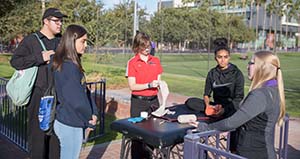
“The goal is to showcase the HSET programs, facilities and clubs that GCU has to offer and show that we are a leader in STEM offerings,” senior marketing event planner Cara Jorgensen said of HSET Day, which is organized by the Marketing Department's ground event planning team.
Students could find another forensics activity going on at one of the booths set up outside by the Forensics Science Society, which was taking students’ fingerprints on balloons and then inflating the balloons to better see their fingerprint and thumbprint patterns.
If you didn’t already know, the club would tell you, it’s all about loops, whorls and arches when it comes to fingerprint analysis.
Seventy percent of the population has a loop-patterned fingerprint, but “we’ve had two or three today that had arches, which is like 5 percent of the population,” said club member Sonia Molina.
Whether 70 percent of the population or 5 percent, “all fingerprints are unique,” Molina added.
Laurel Trail, a GCU athletic training senior, also was manning a booth, this one on biomechanical analysis. The theme of the booth presentation was “Not All Instagram Hotties Should Be Followed,” which looked at how some fitness personalities on Instagram aren’t really doing their exercises the right way.
“If he lands like that, he’s probably going to tear his ACL, which is a nine-month rehab,” Trail said to a group of high school students. She added how athletic trainers are a small part of the medical profession but have a big impact on the general populace.
Besides the forensics lab, other labs that were open for self-guided tours for the first time this year were the engineering labs. Six different engineering lab spaces were on the tour.
It was in the Lopes Lab where biomedical engineering student Erica Bender pointed out a 3D printer, which was busy printing a moon.
“This is where any engineering student can come and work on a personal project,” Bender told visiting students.
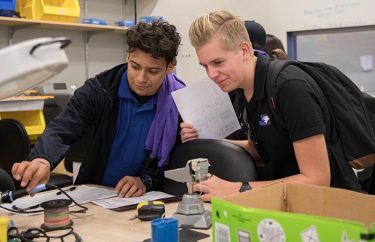
Faculty member Greg Bullock, who teaches mechanical engineering, said the Lopes Lab has been available since the fall of 2016: “We have 3D printers, we’ve got a laser cutter and a small router for making small parts,” Bullock said.
He said what makes GCU’s HSET programs different is that “with this school, we’re emphasizing hands-on training. It’s not like students are sitting in a classroom for an hour and a half. … We lecture for 15 minutes, then the students go through some activities.”
Besides the Lopes Lab, the College of Science, Engineering and Technology building includes a machine shop for students to use when they’re working on prototypes.
Bullock said he knows of a few projects that have made their way through the engineering labs.
“I’m aware of a new product idea surrounding motorized skateboards,” Bullock said, adding that a student team “is making an adapter so you can put your cellphone camera on the end of a telescope.”
Connor Lowe, a junior at Horizon Honors Secondary School, is thinking about going into biomedical engineering, but “I’m worried about the math,” he said while touring the Lopes Lab and being fascinated by all the 3D-printed items, including human hands. "I need to do some research," but he said that career path was being reinforced "just from what I'm seeing here."
Senior Ashley Andrade of Pueblo High School in Tuscon, one of six students from her school's health care club attending HSET Day, has her heart set on studying nursing.
“It’s just something that’s in my family,” she said.
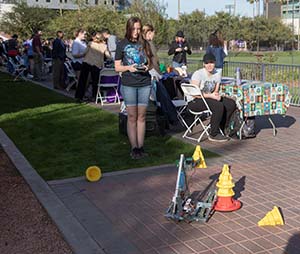
Shea Yeats of Greenway High, who was waiting to tour the DNA Lab and attended HSET Day with about 80 students from the Glendale Union High School District, wants to be a trauma nurse. What she loves about it is “the adrenaline rush … and it’s different every day.”
One of the more interesting parts of HSET Day for Ramon Rodriguez of Mountain View High School in Mesa was visiting the cadaver lab, the most popular tour spot every HSET Day. Attendees had to preregister, and no walk-ins were taken.
“When we went to the cadaver lab, that was very interesting. ... I still have the picture in my head,” he said.
That image isn't putting him off of science, though. Rodriguez, who took his first biotechnology class last year, wants to be a microbiologist or go into the field of biotechnology: "After that (taking that first biotechnology class), I went off with the science world."
Apollo, Taco and Mortimer would be pleased to hear it.
Contact GCU senior writer Lana Sweeten-Shults at (602) 639-7901 or [email protected]. Follow her on Twitter @LanaSweetenShul.















